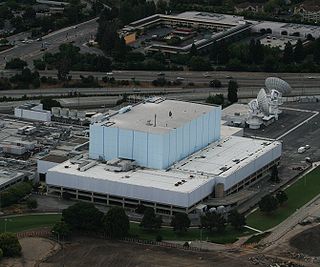
Onizuka Air Force Station or Onizuka AFS was a United States Air Force installation in Sunnyvale, California, at the intersection of State Route 237 and North Mathilda Avenue. It was operational from 1960 to 2010.
The Satellite Control Network (SCN), operated by the United States Space Force's Space Delta 6, provides support for the operation, control, and maintenance of a variety of United States Department of Defense and some non-DoD satellites. This involves continual execution of Telemetry, Tracking, and Commanding (TT&C) operations. In addition, the SCN provides prelaunch checkout and simulation, launch support, and early orbit support while satellites are in initial or transfer orbits and require maneuvering to their final orbit. The SCN provides tracking data to help maintain the catalog of space objects and distributes various data such as satellite ephemeris, almanacs, and other information. It was previously known as the Air Force Satellite Control Network (AFSCN) while under Air Force Space Command's 50th Network Operations Group.
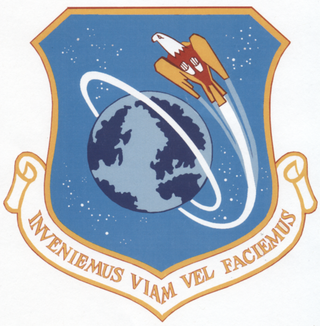
The United States Air Force's Air Force Satellite Control Facility (AFSCF) was a space command and control unit located at Onizuka AFS, California. It has the distinction of being heavily involved in the world's first reconnaissance satellite program, CORONA. Due to geological hazards, and the terrorism threat from its proximity to a major transportation link, the facility's command and control functions were moved to Schriever AFB, Colorado.

New Boston Space Force Station (BOSS) is a United States Space Force facility located in Hillsborough County in south central New Hampshire. It was transferred from the United States Air Force to the Space Force in the summer of 2020.

The 50th Space Wing was the United States Space Force's space and cyber warfare wing. The 50th Space Wing was assigned to Space Operations Command and headquartered at Schriever Air Force Base.
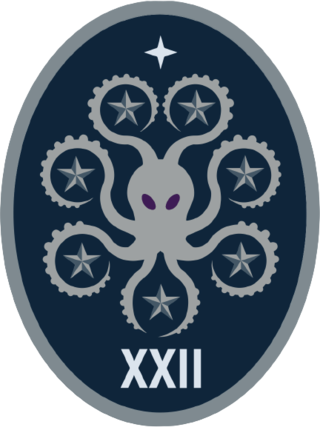
The 22d Space Operations Squadron is a satellite control unit of the United States Space Force. It is part of Space Delta 6 and is located at Schriever Space Force Base, Colorado. Prior to July 2020 it was part of the 50th Network Operations Group, itself a part of the 50th Space Wing.

The 2nd Space Operations Squadron is a United States Space Force unit responsible for operating the Global Positioning System (GPS) satellite constellation, which provides global navigation, time transfer, and nuclear detonation detection. It is a component of Space Operations Command's Positioning, Navigation, and Timing Integrated Mission Delta (Provisional) and headquartered at Schriever Space Force Base, Colorado.

The 3rd Space Operations Squadron is a United States Space Force unit responsible for conducting on-orbit operations. It is located at Schriever Space Force Base, Colorado.

The United States Space Force's 4th Space Operations Squadron is a satellite operations unit located at Schriever Space Force Base, Colorado. 4 SOPS is part of Space Delta 8 and responsible for command and control of the Milstar/Advanced Extremely High Frequency, Defense Satellite Communications System Phase III, and Wideband Global SATCOM satellite constellations. The 4th Space Operations Squadron's mission is to operate the Space Force's protected and wideband MILSATCOM systems. They provide warfighters global, secure, survivable, strategic and tactical communication during peacetime and throughout the full spectrum of conflict. The squadron also operates three mobile constellation control stations at various locations in conjunction with host partners. At higher readiness levels and during exercises, these personnel deploy with U.S. Strategic Command and U.S. Northern Command respectively.

The United States Air Force's 5th Expeditionary Space Operations Squadron is an expeditionary satellite operations unit, assigned to Air Force Space Command to activate or inactivate as needed.

The United States Air Force's 750th Space Group was a space operations unit located at Onizuka Air Force Station, California. its predecessor was formed on 1 October 1987; it assumed the designation of the 750th Space Group on 30 January 1992; and it was inactivated on 25 June 1999.

The 69th Cyberspace Squadron is a squadron of the United States Space Force located at Schriever Space Force Base, Colorado. It is responsible for conducting defensive cyberspace operations enabling operations in support of Space Delta 9's orbital warfare mission at Schriever Space Force Base, Colorado, and Space Delta 6's Satellite Control Network at various locations around the world. It was formed by redesignating the 50th Communications Squadron to the 69 CYS on 15 Oct 2022.
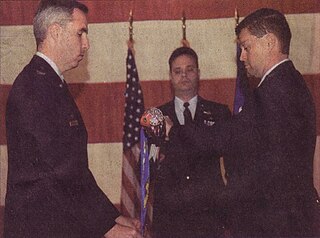
The United States Air Force's 1st Expeditionary Space Control Squadron is a provisional squadron attached to the 21st Space Wing at Peterson Air Force Base, Colorado.

The 1st Space Operations Squadron is a United States Space Force unit responsible for space-based space domain awareness. Located at Schriever Space Force Base, Colorado, the squadron operates the Space Based Space Surveillance system, the Advanced Technology Risk Reduction system, the Operationally Responsive Space-5 satellite, and the Geosynchronous Space Situational Awareness Program.

The 18th Space Defense Squadron is a United States Space Force Space Domain Awareness unit located at Vandenberg Space Force Base, California. The 18th SDS is tasked with executing command and control of the space surveillance network (SSN), maintaining the resident space object (RSO) database and managing United States Space Command's space situational awareness (SSA) sharing program to United States, foreign government, commercial, and academic entities. The squadron also conducts advanced analysis, sensor optimization, conjunction assessment, human spaceflight support, reentry/break-up assessment, and launch analysis.

The 50th Operations Group was a subordinate unit of the 50th Space Wing, and assigned to Air Force Space Command from 1991-2019. The group, redesignated as Space Delta 8 on 24 Jul 2020 is stationed at Schriever Space Force Base, previously Schriever Air Force Base, Colorado.
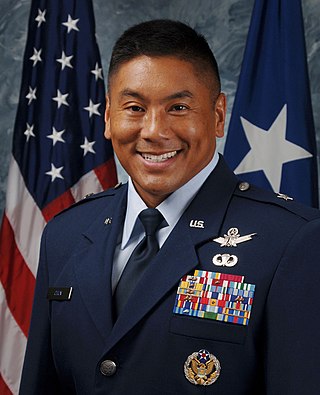
Brigadier General Cary C. Chun is a retired senior officer of the United States Air Force. He served as the Deputy Commander, Operations and Interagency Integration, Joint Functional Component Command for Space, United States Strategic Command (USSTRATCOM), and the Director for Mission Operations, National Reconnaissance Office. In this role, he led all Department of Defense space forces aligned with USSTRATCOM and provided tailored, responsive, local and global effects in support of national, USSTRATCOM and combatant commander objectives. As Director for Mission Operations, he led operations for all NRO overhead reconnaissance systems, ground stations, operational communications, and the operations center used to conduct intelligence activities essential for the national security of the United States and its allies.

The 30th Operations Group was a group of the United States Space Force. It was assigned to the 30th Space Wing, stationed at Vandenberg Air Force Base, California. It was responsible for all space launch operations from the West Coast of the United States, including all polar launches. It operated the Western Range, which conducts launches for the Space Force, other parts of the Department of Defense, NASA, and private space corporations. In 2021 the 30th Operations Group and the 30th Mission Support Group were inactivated and squadrons assigned to Space Launch Delta 30.

The 23rd Space Operations Squadron is a satellite control unit of the United States Space Force. It is part of Space Delta 6 and is located at New Boston Space Force Station, New Hampshire. Prior to July 2020, part of the 50th Network Operations Group, itself a part of the 50th Space Wing.

Space Delta 6 is a United States Space Force unit which assures access to space through the $6.8 billion Satellite Control Network and defensive cyberspace capabilities for space mission systems.




















